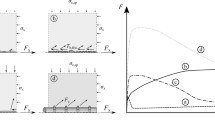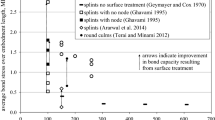Abstract
With the growth and ageing of the stock of existing structures, structural assessment and retrofitting are fast acquiring a significant role in the construction industry. The benefits of upgrading existing reinforced concrete (RC) structures or extending their service life and of ensuring greater durability in designs for de novo construction have led to a need to include deterioration as a factor in structural safety models. Bond between reinforcing steel and concrete is of cardinal importance in this respect. The present paper proposes a unified formulation for assessing bond strength in corroded and non-corroded steel bars, and an associated model to accommodate the effect of transverse pressure where appropriate. The formulation is the result of applying multiple linear regression analysis to a database built from the findings of over 650 bond tests on corroded and non-corroded reinforcing steel reported in the literature. The data collected include a wide range of variables affecting bond strength, such as bar diameter, concrete compressive strength, concrete cover, anchorage length, confinement ratio and cross-sectional loss. A number of statistical criteria are used to compare the proposed formulation to the other bond strength assessment models, including the fib Model Code 2010 proposal for corroded steel bars. Further to the statistical tests conducted, the model proposed can be usefully applied to assess the structural safety of corroded RC members.





Similar content being viewed by others
References
Coccia S, Imperatore S, Rinaldi Z (2014) Influence of corrosion on the bond strength of steel rebars in concrete. Mater Struct. doi:10.1617/s11527-014-0518-x
Fischer C (2012) Influences of reinforcement corrosion on bond between steel and concrete (in German). Ph.D. Thesis, Stuttgart University
Yalciner H, Eren O, Sensoy S (2012) An experimental study on the bond strength between reinforcement bars and concrete as a function of concrete cover, strength and corrosion level. Cem Concr Res 42:643–655. doi:10.1016/j.cemconres.2012.01.003
CEB (1982) Bulletin d’Information 151. Bond action and bond behaviour of reinforcement. CEB, Paris
FIB (2000) Fib Bulletin 10. Bond of reinforcement in concrete. FIB (International federation for structural concrete), Lausanne
CEN (2004) Eurocode 2: design of concrete structures—part 1-1: general rules and rules for buildings. CEN, Brussels
FIB (2013) Fib Model Code for concrete structures 2010. FIB (International Federation of Structural Concrete), Lausanne
FIB (2014) Fib Bulletin 72. Bond and anchorage of embedded reinforcement: background to the fib Model Code for concrete structures 2010. FIB (International federation for structural concrete), Lausanne
Tepfers R (1973) A theory of bond applied to overlapped tensile reinforcement splices for deformed bars. Ph.D., Chalmers University of Technology
Schenkel M (1998) Bond behaviour of reinforcement with reduced Concrete Cover (Zum Verbundverhalten von Bewehrung bei kleiner Betondeckung—in German). Ph.D., Swiss Federal Institute of Technology Zürich (ETHZ)
Shima H, Chou LL, Okamura H (1987) Bond characteristics in post-yield range of deformed bars. Proc Jpn Soc Civ Eng (JSCE) 6:79–94
Mathey RG, Watstein D (1961) Investigation of bond in beam and pull-out specimens with high yield-strength deformed bars. J Am Concr Inst 57:1071–1090
Metelli G, Plizzari GA (2014) Influence of the relative rib area on bond behaviour. Mag Concr Res 66:277–294. doi:10.1680/macr.13.00198
Cairns J (2015) Bond and anchorage of embedded steel reinforcement in fib Model Code 2010. Struct Concr 16:45–55. doi:10.1002/suco.201400043
Prieto M, Tanner P, Andrade C, Fernandez Ruiz M (2013) Experimental and numerical study of bond response in structural concrete with corroded steel bars. Paper presented at the IABSE Conference on Assessment, Upgrading and refurbishment of Infrastructures, Rotterdam
Tondolo F (2015) Bond behaviour with reinforcement corrosion. Constr Build Mater 93:926–932. doi:10.1016/j.conbuildmat.2015.05.067
Rodriguez J, Ortega LM, Casal J, Díez JM (1995) The residual service life of reinforced concrete structures. Task 3.2. Relation between corrosion and bond deterioration. Geocisa, Madrid
Al-Sulaimani GJ, Kaleemullah M, Basunbul IA, Rasheeduzzafar (1990) Influence of corrosion and cracking on bond behavior and strength of reinforced concrete members. ACI Struct J 87:220–231
Almusallam AA, Al-Gahtani AS, Aziz AR, Rasheeduzzafar (1996) Effect of reinforcement corrosion on bond strength. Constr Build Mater 10:123–129. doi:10.1016/0950-0618(95)00077-1
Alonso MDG (1995) Aportaciones al comportamiento resistente de estructuras de hormigón armado afectadas por la corrosión de sus armaduras (Contributions to the resistance behaviour of reinforced concrete structures affected by corrosion—in Spanish). Universidad Politécnica de Madrid (UPM), Madrid
Auyeung Y, Balaguru P, Chung L (2000) Bond behavior of corroded reinforcement bars. ACI Struct J 97:214–220
Chamberlin SJ (1956) Spacing of reinforcement in beams. Proc J Am Concr Inst 53:113–134
Ezeldin AS, Balaguru PN (1989) Bond behaviour of normal and high strength fibre reinforced concrete. Am Concr Inst Mater J 86:515–524
Fang C, Lundgren K, Chen L, Zhu C (2004) Corrosion influence on bond in reinforced concrete. Cem Concr Res 34:2159–2167. doi:10.1016/j.cemconres.2004.04.006
Ferguson PM, Thomson JN (1962) Development length of high strength reinforcing bars in bond. Proc J ACI 59:887–922
Hanjari KZ, Coronelli D (2010) Anchorage capacity of corroded reinforcement. Eccentric pull-out tests. Chalmers University of Technology, Göteborg
Lee HS, Noguchi T, Tomosawa F (2002) Evaluation of the bond properties between concrete and reinforcement as a function of the degree of reinforcement corrosion. Cem Concr Res 32:1313–1318. doi:10.1016/S0008-8846(02)00783-4
Molina M (2005) Comportamiento de estructuras de hormigón armado con una deficiente transferencia de tensiones hormigón-acero (Structural behaviour of reinforced concrete structures with a deficient transfer of stresses between concrete and steel—in Spanish). Ph.D. Thesis, Universidad Politécnica de Madrid (UPM)
Tang D (2007) Influence of chloride-induced corrosion cracks on the strength of reinforced concrete (Master Thesis). Master Thesis, RMIT University
Andrade C, Alonso C (1996) Corrosion rate monitoring in the laboratory and on-site. Constr Build Mater 10:315–328. doi:10.1016/0950-0618(95)00044-5
Mancini G, Tondolo F (2014) Effect of bond degradation due to corrosion—a literature survey. Struct Concr 15:408–418. doi:10.1002/suco.201300009
Prieto M (2014) Estudio de la adherencia de armaduras corroídas y su influencia en la capacidad resistente de elementos de hormigón armado (Study of bond with corroded steel and its influence in the resistance of reinforced concrete elements—in Spanish). Ph.D. Thesis, Universidad Politécnica de Madrid (UPM)
Prieto M, Tanner P, Andrade C (2014) Bond assessment of corroded steel bars in structural concrete. Paper presented at the 37th IABSE Symposium on Engineering for Progress, Nature and People, Madrid, 2014
IBM SPSS Statistics for Windows (2012) IBM SPSS statistics for Windows, 21 edn. IBM Corp, Armonk, NY
Peña D (2002) Regresión y diseño de experimentos (Regression and design of experiments—in Spanish). Alianza Editorial, Madrid
IETcc (2001) Contecvet manual. A validated users manual for assessing the residual service life of concrete structures. Instituto Eduardo Torroja (IETcc), Madrid. www.ietcc.csic.es
ACHE (2012) Monografía M-19. Modelos lineales aplicados al hormigón estructural (Linear models applied to structural concrete—in Spanish). Asociación científico-técnica del hormigón estructural (ACHE), Madrid
Author information
Authors and Affiliations
Corresponding author
Rights and permissions
About this article
Cite this article
Prieto, M., Tanner, P. & Andrade, C. Multiple linear regression model for the assessment of bond strength in corroded and non-corroded steel bars in structural concrete. Mater Struct 49, 4749–4763 (2016). https://doi.org/10.1617/s11527-016-0822-8
Received:
Accepted:
Published:
Issue Date:
DOI: https://doi.org/10.1617/s11527-016-0822-8




